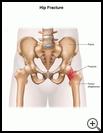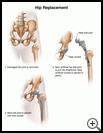
Hip (Femur Neck) Fracture
What is a hip fracture?
The hip is the joint where the top of the bone in your upper leg (called the femur or thighbone) meets the pelvic bone. The hip joint is called a ball and socket joint. The top of the femur (called the femoral head) is rounded, like a ball. It fits into a concave area (socket) on the pelvic bone called the acetabulum. A hip fracture is a break at the upper end of your femur, close to where the femur meets the pelvic bone. It is a serious injury.
You are more at risk for a hip fracture if you:
- Are a woman who is past menopause
- Are an older adult
- Have osteoporosis, which is thinning and weakening of the bones
- Have a disease that weakens the bones, such as cancer, kidney disease, or parathyroid disease
- Take medicine that weakens your bones
- Do not get enough vitamin D or calcium in your diet
What can I expect in the hospital?
You need to stay in the hospital because you need surgery or other treatment to treat your hip fracture.
Several things may be done while you are in the hospital to monitor, test, and treat your condition. They include:
Monitoring
- You will be checked often by the hospital staff.
- Your heart rate, blood pressure, and temperature will be checked regularly.
Testing
Testing may include:
- Blood tests to check for an infection or blood loss
- X-rays: Pictures of the inside of the hip to check for a fracture
- Magnetic resonance imaging (MRI): A powerful magnetic field and radio waves are used to take pictures from different angles to show thin cross sections of the hip.
- Computed tomography (CT) scan: A series of X-rays is taken from different angles and arranged by a computer to show thin cross sections of the hip. This test may be done if you have metal in your body that prevents you from having an MRI.
- Bone scan: A series of detailed pictures is taken after your healthcare provider injects a small amount of radioactive material into your blood. The scan shows any areas of bone where the radioactive material is being absorbed and may show a small fracture.
Treatment
The treatment for hip fracture depends on the position of the bones, your overall health, and any complications you may have.
- You will have a small tube (IV catheter) inserted into a vein in your hand or arm. This will allow for medicine to be given directly into your blood and to give you fluids, if needed.
- Your provider will put traction on the leg with the broken hip. This involves putting a cloth boot on your foot and lower leg and attaching it to just enough weight to pull your broken bones back into the right position.
- In rare cases, you may be required to stay in bed and keep your leg still to allow the bone to heal without surgery. This is more likely if you are very ill and unable to tolerate surgery or if you were unable to walk and were confined to a wheelchair or bed before the injury.
- You will probably need surgery to treat your hip fracture. Surgery may include:
- Open reduction and internal fixation (ORIF): Surgery to stabilize the femur with pins, rods, or screws
- Partial hip replacement (hemiarthroplasty): Surgery to replace the femoral head with an artificial one
- Total hip replacement (total hip arthroplasty, or THA): Surgery to replace both the femoral head and socket with metal, ceramic, or plastic parts
- Your provider may prescribe medicine to:
- Treat pain
- Treat or prevent an infection
- Treat or prevent side effects, such as nausea or constipation, from other treatments
- Help prevent blood clots
- Help build bone and prevent bone loss
- Your provider may recommend other types of therapy to help relieve pain, other symptoms, or side effects of treatment.
- Your leg may be moved regularly with a machine to help muscle and bones heal. This is called continuous passive motion or CPM.
- You may need therapy to help you recover from a hip fracture. Most rehabilitation programs include:
- Physical therapy to help you regain muscle strength and teach you ways to move safely
- Occupational therapy to help you relearn ways to do the tasks that you previously did
What can I do to help?
- You will need to tell your healthcare team if you have new or worsening:
- Pain that is not controlled with your medicines
- Redness, swelling, pain, warmth, or drainage from your surgical wound
- Fever, chills, or muscle aches
- Swelling in your leg, ankle, or foot on the side of your hip fracture
- Coldness or change in color of the skin of your leg, ankle, or foot on the side of your hip fracture
- Warmth, redness, or pain in your leg
- If you are taking medicine to prevent blood clots, unusual or unexpected bleeding
- Ask questions about any medicine, treatment, or information that you do not understand.
How long will I be in the hospital?
How long you stay in the hospital depends on many things, such as your general health, why you are in the hospital, and the treatment you need. The average amount of time to stay in the hospital with a hip fracture is 3 to 5 days. Talk with your provider about how long your stay may be.
You may need to go to a rehab facility to continue your rehab program before going home.
Last modified: 2015-12-21
Last reviewed: 2015-12-21



